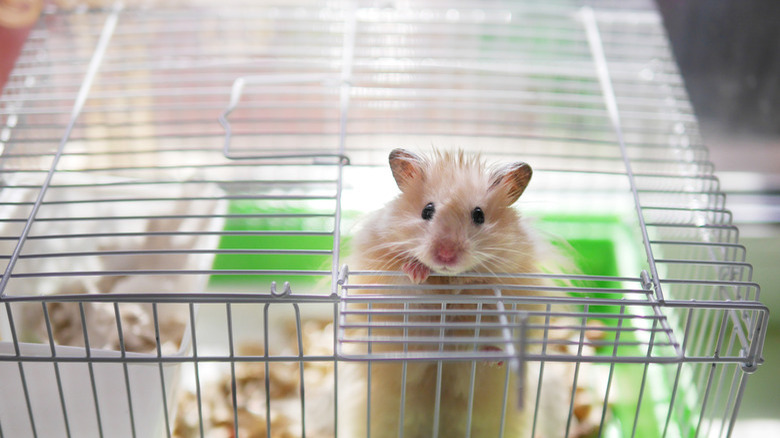How To Get Rid Of Fleas On Hamsters
Your hamster is cute and cuddly, looking to you for food, water, and a bit of attention each day. Hamsters are relatively low-maintenance when compared to other pets, but that doesn't mean they don't need special treatment from time to time. Just like your cats and dogs, hamsters can become infested with fleas. While it's fairly rare, knowing how to treat and manage hamster fleas can help to make your hamster's infestation a short-lived one.
Identifying hamster fleas
Fleas are fairly large, and you can see them with your naked eye. Omlet recommends that you push your hamster's hair apart to look for fleas. You can also identify if fleas are present by examining their droppings. Flea droppings also called flea dirt, will look like little black dots. If you brush them out onto a paper towel and add a drop of water, the black droppings will turn red because of the digested blood they contain.
If your hamster is unusually itchy, though, it's possible that he has mites.
According to PetMD, it's fairly common to find mites on hamsters. On occasion, mite infestations can occur. A hamster suffering a mite infestation may be very itchy and may rub up against the cage bars in an effort to relieve the itching. You may also see scaly skin or hair loss.
In order to treat your hamster, you need to determine if he has mites or fleas. It is possible that you may see hamster fleas, whereas mites will be so small that you can't see them. If you're not sure which problem is affecting your hamster, take him to the vet. Your vet may do a skin scraping to diagnose mites and will be able to tell you the best way to treat your hamster's itching.
Treating fleas on hamsters
According to a pet specialist on JustAnswer, "Your local pet store should have a variety of flea sprays and treatments that are made for hamsters. Be sure to use only products intended for hamsters, and always carefully follow the directions on those products. Never substitute out a spray made for a cat or a dog on your hamster, since the chemicals they contain can jeopardize your hamster's health."
In addition to treating the fleas on your hamster, you'll want to simultaneously clean your hamster's cage. Putting your hamster back in the dirty cage will only cause her to be reinfected when she comes into contact with other fleas or their eggs. Instead, clean out the entire cage and throw out all the old bedding. Rinse the cage out thoroughly with warm water, let it dry, and put in new bedding. If there are any cardboard tubes or other permeable materials in the cage, you'll need to discard them since they're a potential breeding ground for hamster flea eggs.
Treating your other animals
When your hamster has fleas, the other pets in your home probably have fleas, too. It's important to treat all your pets simultaneously, or the fleas will just continue laying eggs, hatching, and infesting your pets. It can take several months of treating your pets before you get all the flea life cycles under control and can eliminate the pests from your home.
According to Doctors Foster and Smith, you can choose from a number of products designed to kill fleas on your pets. For active infestations, you may want to start with a flea comb, which will allow you to literally comb the fleas out of your pet's coat. Then, follow up with another method.
Topical flea medications are applied monthly. They're long-lasting and some even help to kill ticks. Some of the topical medications intended for dogs can be highly toxic to cats, though, so choose carefully if you have multiple pets in the home.
Flea collars can also be effective, but it's important to apply the collar appropriately. Make sure that you note how long the collar is effective for, and swap it out for a new one once its useful life is up.
Flea shampoos and dips are other popular options. Flea shampoos tend to be less harsh for animals, whereas dips can have long-lasting effects. Be sure that you follow the directions carefully for any product.
If you're unsure of what flea treatment plan is right for your home, talk with your vet about your different pets so you can come up with the right plan that will keep everyone safe.
Treating your house
If your pets, including your hamster, have fleas, then the fleas are likely in your home, too. Just treating your pets for fleas isn't enough to address the problem and you'll also need to treat your house.
Doctors Foster and Smith recommend that you thoroughly vacuum your house to remove flea eggs. Pay particular attention to the areas where your pets sleep, and if you have hardwood floors, make sure to vacuum the cracks between the floors. Once you're done, seal your vacuum bag in a plastic bag and throw it away.
You will also need to wash any bedding that your pets use, and treat carpeting with a product that kills off adult fleas and stops egg production. There are a variety of products to choose from, including surface sprays and foggers. Be sure to follow the directions and read the warnings on these products, since they can carry risks for pets, children, and people with asthma.
